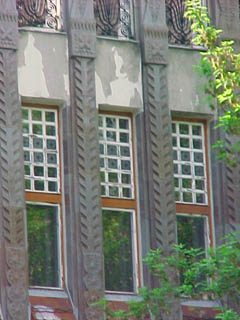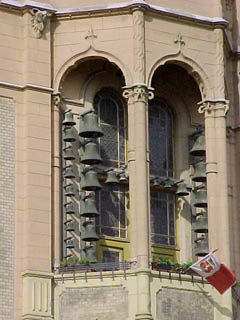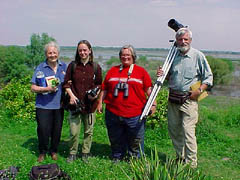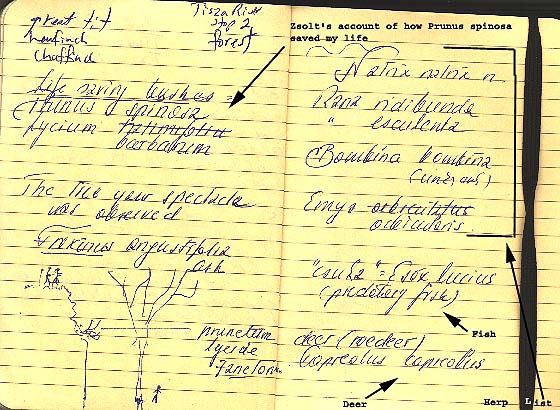|
Journal of a Sabbatical |
||||||||
|
April 30, 2001 |
|
|
extreme birding |
|||||
|
|
|
|
|
|||||
|
Today's
Bird Sightings: Today's Reading: Budapest 1900 by John Lukacs
Birdwatch Hungary Photo Gallery -- on their website FHO and Son of FHO have some photos of some of the birds I've mentioned - including Otis tarda Bird Life Hungary -- sort of like the Hungarian equivalent of the Audubon Society Plum Island Bird List |
|
|
After a breakfast of whatever was left from the snacks we packed the day before yesterday and some juice that Zsolt bought at a petrol station where we asked directions and no coffee as the leftover coffee was not enough for all three of us, I took a walk in the arboretum. The Kecskemet Arboretum is relatively new, only 24 years old, so the trees are small and young - kind of adolescent trees. I found Zsolt - near the conifers of course - and he showed me a giant sequoia that was planted when the arboretum was started. It's taller than one he planted in his garden at Lake Balaton even though it's younger, so giant sequoias must like the pustza better. It seems odd thinking of these trees and this place as just barely getting started, but when I compare it to a place like Arnold Arboretum it makes sense. Well as much sense as the length of time it takes trees to grow makes in today's 24/7 speeded-up world. You can't just order a giant sequoia to grow faster or even offer it stock options to "incentivize" it to grow faster. Some things still take time.
Son of FHO arrives to take us on an
overview tour of downtown Kecskemet and then to the Tisza
River for more birding. The idea was that if we failed in
the Otis tarda mission yesterday, he would take us to
other possible Otis tarda places today. Once we found
Otis tarda last night, we changed the agenda to
possible pygmy cormorant, which is found in the Tisza River
environs. Zsolt informs Son of FHO that our first project
has to be coffee because our supply had run out. We "made
the coffee project" at a sidewalk cafe in Kecskemet, after
which we checked out the famous Art Nouveau buildings, the
Kodaly School, the city hall with its carillon, a highly
ornamented building that I think is actually named something
like The first birding stop was a small hill overlooking the Tisza River. What ? A hill on the plain? Well it was more like a high embankment of loess with sand martin nests in the side and grass on top surrounding a small church. The river is very wide at that point and just bursting with ducks, egrets, herons, cormorants, storks, gulls, terns, and even a few mute swans (they're everywhere - taking over the world). Son of FHO set up the scope and we took turns looking at a pair of garganey. The male in breeding plumage is way more spectacular than the eclipse male I saw at Plum Island in August. It's kind of fun getting to see them in their real habitat instead of as a rarity blown in on the wind. He trained the scope on a small flock of ferruginous ducks, those compact reddish ducks. Them I had not seen before and I happily added them to the list in my notebook. A huge flock of cormorants sat drying their wings on a small island, all greats though -- no pygmies. What a gorgeous scene! The sun and the accumulated fatigue from yesterday started to get to me. Son of FHO's girlfriend was sitting on the edge of the embankment and the idea of sitting down to survey the scene at rest appealed to me. I leaned a little forward to look down to see if there was a safe place to sit. The ground gave way underneath me. I slid down the embankment and then started to roll. It all happened so fast I didn't have time to be afraid or to think. I just rolled until I came to a stop in a thicket of blackthorn bushes. I started laughing. I don't know why. It's some physical reflex. Zsolt and Son of FHO came after me. I tried to climb backup but the loess was wet, soft , and slippery - hard to get solid footing. I swallowed a mouthful of grass. They pushed and pulled and I struggled to get back to the top of the embankment. Finally, covered with dirt and scratches, I crawled up over the edge of the embankment and then kept crawling toward the small church and away from the edge. I was almost afraid to stand up. The spot where I had landed in the thorn bush was the edge of a sheer dropoff of anther 25 or 30 feet. Zsolt admitted to being afraid I would fall the whole way down, be killed, and my expertise be lost to the project forever. Life saved by a shrubbery! Actually, I probably wouldn't have been too badly hurt because I would have slid down the embankment rather than plummeted. Zsolt declared that from now on I would look at Prunus spinosa differently. Prunus spinosa, also called blackthorn or sloe is a densely spiny shrub. I've read that it produces masses of small white flowers before the leaves in spring, but it was fully foliaged today. Its juicy fruits (technically known as drupes) are called "sloes". They're supposedly far too bitter for human consumption, but are used to flavor homemade liqueurs -- I always wondered what sloe gin was. Here's a photo showing it with fruits. There were no fruits on it today either as they appear in the fall, umm, autumn - they didn't appear to me during my fall :-) I recovered myself enough to notice I was missing something. My glasses! They must have fallen off when I was rolling down the embankment. A long search ensued. I stayed put, with Zsolt's mother frequently warning me away from the edge while the other three plus a bunch of little kids to whom they paid a few forints, searched for my glasses. Eventually, Son of FHO's girlfriend found them in a tree some distance from where I landed.
And I thought yesterday proved that birding is an extreme sport... *Note: sand martin is the European common name for Riparia riparia - what we North Americans call the bank swallow |
|||||
|
|
|
Copyright © 2001, Janet I. Egan |
|||||
 Zsolt
found me sleeping on the floor in my room this morning. It's
not that the beds at the Kecskemet Arboretum are
uncomfortable. It's just that I had another one of those
falling out of bed while dreaming in Hungarian dreams again.
So rather than risk falling out of bed again, I piled up the
quilts on the floor. I was actually quite comfortable. I had
told him to wake me if I wasn't up by 8:00. They knocked on
my door at 7:00. Apparently I had misunderstood "Son of FHO
will be here at 8:00" as "we have to get up by 8:00".
Duh.
Zsolt
found me sleeping on the floor in my room this morning. It's
not that the beds at the Kecskemet Arboretum are
uncomfortable. It's just that I had another one of those
falling out of bed while dreaming in Hungarian dreams again.
So rather than risk falling out of bed again, I piled up the
quilts on the floor. I was actually quite comfortable. I had
told him to wake me if I wasn't up by 8:00. They knocked on
my door at 7:00. Apparently I had misunderstood "Son of FHO
will be here at 8:00" as "we have to get up by 8:00".
Duh. The
arboretum looks beautiful from the top of the observation
tower, all green and alive and growing. The puszta spreads
out all around Kecskemet as far as I can see from the tower.
And it's a gorgeous morning for birding.
The
arboretum looks beautiful from the top of the observation
tower, all green and alive and growing. The puszta spreads
out all around Kecskemet as far as I can see from the tower.
And it's a gorgeous morning for birding.  "highly ornamented building" in Hungarian, and the
synagogue.
"highly ornamented building" in Hungarian, and the
synagogue. Son
of FHO declared we couldn't leave this place without a
picture. I think I don't look too much the worse for wear,
but I was still numb and goofy from the fall. And was there
any question about whether we would continue birding at the
next spot? Nope. We headed to a riverine forest where we
might find the black woodpecker - another of my target
species. The woods were gorgeous but also busy with people
because of the holiday weekend. I can hardly blame the black
woodpecker for hiding out. So we enjoyed a lovely walk in
the woods, taking advantage of the welcome shade.
Afterwards, we stopped for lunch at a nearby restaurant and
Zsolt drew/wrote his account of the expedition in my bird
notebook.
Son
of FHO declared we couldn't leave this place without a
picture. I think I don't look too much the worse for wear,
but I was still numb and goofy from the fall. And was there
any question about whether we would continue birding at the
next spot? Nope. We headed to a riverine forest where we
might find the black woodpecker - another of my target
species. The woods were gorgeous but also busy with people
because of the holiday weekend. I can hardly blame the black
woodpecker for hiding out. So we enjoyed a lovely walk in
the woods, taking advantage of the welcome shade.
Afterwards, we stopped for lunch at a nearby restaurant and
Zsolt drew/wrote his account of the expedition in my bird
notebook.